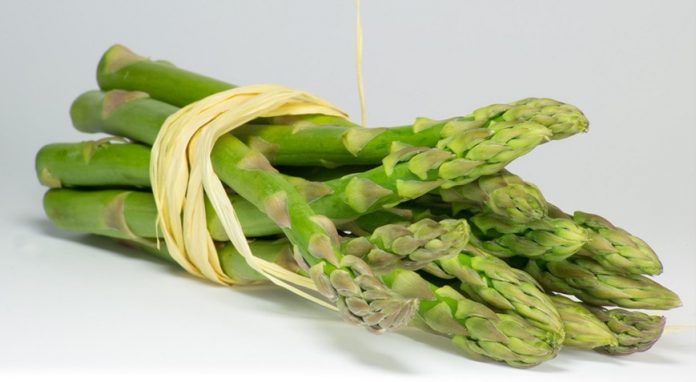Is your dog a veggie lover? It’s so easy to give in when he begs you for a bite of asparagus. After all, asparagus is one of the wholesome and nutritious veggies for canines. Most dogs eat it and turn out just fine. But is that always the case? Keep reading to find out the good and the bad things about this spring vegetable.
Can Dogs Have Asparagus?
Yes, dogs can eat asparagus! Just make sure dog does not consume as much asparagus as he wants. This veggie can be a great addition to your pet’s diet as long as it is given in moderate amounts.
As the line goes, too much of everything is bad so you should pay attention to the amount of asparagus you’re serving to your dog. Around three to six spears of asparagus per day are enough for a dog. This amount only has 25 calories and around 61% of these calories are from carbohydrates while the rest are derived from protein.
Ways to Offer Asparagus to Dogs
- Steamed – steaming asparagus is the best way to retain most of its nutrients. Some dog owners even save the steaming water and give it to their pets once cooled. Steaming thin asparagus should not take more than 5 minutes while the thicker pieces can be cooked for up to 8 minutes.
- Boiled – it takes 5 minutes or less to boil small and medium asparagus. For bigger pieces, you can boil them for around 7 minutes or until they are tender. Don’t over boil the asparagus to avoid depleting its nutritional value.
- Grilled – you may coat the spears with a small amount of olive oil before grilling. Season with a bit of salt to taste. Cook the spears for around 3 minutes.
- Blanched – if you have asparagus in the fridge and want to serve it to your dog, consider blanching it first. It is as simple as laying them in a microwave dish with 2 tablespoons of water for every pound. You just have to wait for two minutes or until the veggies turn bright green. Once you removed the veggies from the microwave, plunge them in ice-cold water and drain.
Risks of Giving Too Much Asparagus to Dogs
Eating too much asparagus isn’t life-threatening for dogs, but it can cause unlikely side effects to them. Here are the most common risks associated with consuming too much of this veggie:
- Unpleasant urine smell – The most notorious aftereffect when consuming a lot of asparagus is having a stinky urine. The Smithsonian Magazine explained that the acid in this veggie, aka the asparagusic acid, is responsible for this unpleasant odor. Once it gets digested, it breaks down into compounds that contain sulfur. As science tells us, molecules comprising sulfur normally emit an unpleasant odor.
- Gas – dog could suffer from flatulence after eating too much asparagus. The excess gas is due to its raffinose content. This complex carbohydrate contains glucose, fructose, and galactose that are responsible for Fido’s flatulence.
- Pungent stool – Don’t be surprised if your dog’s stool smells more pungent after consuming asparagus. Again, the culprit for this not-so-pleasant smell is the sulfur. If your dog defecated in your backyard, make sure to scoop the stool and spray an odor eliminator to avoid attracting flies.
- Digestive issues – because asparagus contains dietary fiber, too much of it can lead to digestive problems with symptoms like vomiting and diarrhea. If this is the first time that your dog eats asparagus and has stomach problems, better not give him anymore.
- Dehydration – asparagus can cause excessive urination in canines due to its diuretic property. Unknowingly to some, it is not only the toxins that get eliminated during the process. Excessive urination can also flush out lots of water that can lead to dehydration.
Benefits of Asparagus for Canines
Now we’re down to the more exciting part – the benefits of asparagus for canines. Asparagus is a low-calorie treat for canines. When your dog is on the heavy side and you want to give him a tasty and nutritious treat without feeling guilty afterward, asparagus is one of your best options. More than that, below are more reasons to feed your dog asparagus.
- It supplies a great amount of protein. A cup of fresh asparagus contains around 2.9 grams of protein. As we all know, canines need this macronutrient as much as humans do for many body functions. Protein plays a crucial role in building muscle mass as well as repairing tissues.
- It gets rid of toxins from the body. As a natural diuretic, asparagus increases the amount of salt and water that comes out through your dog’s urine. Similar to humans, canines can also have bladder and kidney stones. Asparagus is a kidney-friendly food because it helps prevent the occurrence of stones.
- Asparagus can improve your dog’s digestion. In the event that your dog is suffering from constipation, consider offering him fiber-rich foods before resorting to medications. The high fiber in asparagus is helpful in stabilizing digestion in humans and animals.
- It is essential for blood coagulation. Did you know that asparagus is the number one plant source of vitamin K? This fat-soluble vitamin helps in regulating Fido’s blood function.
- It is known for its high anti-carcinogen properties. There are several claims that eating pureed asparagus on a daily basis can cure cancer. The American Institute for Cancer Research clarified that this is just a rumor. In spite of that, they emphasized that the nutrients found in asparagus can offer extra protection against cancer.
Important Reminders for Dog Owners
Dogs can eat raw veggies, but take note that not all raw vegetables are easy for them to digest. Raw asparagus can be a choking hazard for canines because it can be quite hard for them. While “fresh is best,” it is better to lightly steam the asparagus rather than offering it raw in order to avoid choking.
The asparagus stems are safe to eat. The ferns aren’t. The asparagus fern is a popular indoor plant because it is easy to plant and grow, not to mention that it is an attractive plant.
If you have this plant at home, make sure dog does not eat the berries. Otherwise, he will suffer from vomiting and abdominal pain because the berries on the fern contain sapogenin, a steroid that is toxic to dogs and cats.
Aside from avoiding the ingestion of this plant, it is also important to keep yourself and your dog away from it. The sap of asparagus fern can cause skin rashes to both dogs and humans. The sapogenin is also the reason for the dermal reaction.
In case dog comes in contact with this sap, rinse his skin immediately. If he develops redness, swellings, and blistering, consult a veterinarian so he can prescribe the right medication for dog. In most cases, vets recommend pain relief and anti-inflammatory drugs to deal with the discomfort.
How to Choose Fresh Asparagus For Dog
The color of the spears is the first thing to look at when buying asparagus. They should have a bright green or violet-tinged color.
Aside from the color, also check if the vegetable is firm. Squeeze the bunch and see if it squeaks. If it doesn’t, it means the asparagus is no longer fresh. Don’t buy asparagus with woody stalks. The spears are not supposed to look dry and wrinkled. If you want more tender asparagus for dog, choose one with thinner spears.
The shelf life of asparagus greatly depends on the way it is stored. When this is done properly, both fresh and cooked asparagus can last for five to seven days.
Asparagus Recipes for Canines
Lightly cooked asparagus is the best option for dogs since it retains most of the vegetable’s nutrients. However, that does not mean you can’t incorporate asparagus in your dog’s favorite meals. If you enjoy cooking for your dog, you will take pleasure in creating these dishes because they are simple and easy to make:
Chicken with Asparagus
This meal is packed with protein because both chicken and asparagus contain impressive amounts of this nutrient. Boling the chicken gets rid of the Salmonella bacteria. It’s also important to shred the chicken meat so your dog will have an easier time eating. Follow these steps to make a protein-heavy treat for Fido:
- Boil the chicken meat. Once it is cooked and cooled, shred it or cut it into bite-sized chunks.
- Put the meat in a medium bowl. Add in a cup of cooked peas.
- Add in around six spears of previously boiled asparagus. Chop it into bite-sized chunks to make it easier for dog to chew.
- If your pooch is taking dog food vitamins, you may add half a cup of them in the meat and veggie mixture. Just make sure the meal has completely cooled because the heat could affect the efficacy of the vitamins.
- Serve the meal to your dog. The ideal serving size is a cup for every 5 pounds of body weight. If dog is around 30 pounds, you may give him as much as 4 cups per day. However, you have to divide it in two portions. You may offer the food once in the morning and once in the evening.
Salmon with Asparagus and Apples
Salmon is an excellent source of omega-3 fatty acids and DHA. It is a great addition to your dog’s diet because it is good for brain and vision development. The asparagus makes this dish more nutritious. The apples, on the other hand, make this savory dish more interesting for canines because they add some sweetness to the food. Here’s how to do it:
- Marinate 2 lbs. of deboned salmon planks by adding ½ cup of maple syrup and 3 tablespoons of olive oil. The marinade uses a clove of garlic but you can skip that if you are not comfortable with using garlic in dog’s food.
- Leave it out on the fridge for two hours.
- Once it is ready, discard the marinade and take out the salmon.
- Spray a baking pan with a bit of cooking spray.
- Put the salmon in the pan. Top it with small chunks of apples.
- Top the apples with ½ pound of bite-sized asparagus. When converted, that is equivalent to six spears of medium asparagus.
- Bake for 40 minutes at 375 degrees.
- Allow the food to cool before giving it to dog.
Eggs, Broccoli, and Asparagus
Eggs can be the perfect alternative when you run out of chicken. They are tasty and you can turn them into a gourmet dish for your dog. When you are in a hurry and want to prepare something healthy for Fido, don’t hesitate to try this recipe:
- Slice the broccoli and asparagus in small bite-sized chunks.
- Stir-fry the veggies in a medium pan. Crack in 2 brown eggs.
- Stir-fry until the egg is cooked.
- Remove from the heat.
- Serve the food to your dog once it is cool.
Just a reminder before cooking these asparagus dishes: consult your vet if you are planning to include this vegetable in dog’s diet. If this is the first time you’re giving it to your dog, only offer it in small amounts and see how your dog reacts to it. If he suffers from diarrhea or vomiting, stop giving asparagus to your pet.
Conclusion
Like we always remind our readers, moderation is the key to a successful feeding. That certainly applies to vegetables, like asparagus. Dog can benefit from this veggie big-time, due to its impressive fiber, vitamins, and protein content. Just offer it in moderate amounts to avoid the unlikely side effects associated with asparagus such as flatulence, unpleasant urine smell, and dehydration.





















